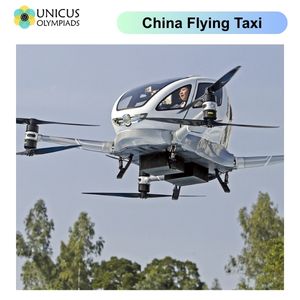Which Nations Led in High-Speed Rail or Flying Taxis?
High-speed rail and flying taxis represent the cutting edge of transportation technology, offering faster, more efficient ways to move people and goods across distances. These innovative transportation systems have the potential to reshape global travel, reduce congestion, and significantly lower carbon emissions. Some nations have taken the lead in developing high-speed rail networks and experimenting with flying taxi technologies. This article explores the countries at the forefront of these transportation revolutions, highlighting their achievements, challenges, and future plans for high-speed rail and flying taxis.
1. High-Speed Rail: Leading Nations in Speed and Innovation
High-speed rail (HSR) refers to trains that run at speeds significantly higher than traditional rail, often exceeding 300 km/h (186 mph). High-speed rail networks are crucial for reducing traffic congestion, offering sustainable alternatives to air travel, and promoting regional connectivity. A few countries are pioneers in HSR, with extensive networks and future expansion plans. Let’s examine the leading nations in high-speed rail development.
1.1 Japan: The Pioneer of High-Speed Rail
Japan is widely considered the birthplace of high-speed rail, having introduced the first bullet train, the Shinkansen, in 1964. The Shinkansen revolutionized rail travel, reducing travel times between major cities and setting the standard for HSR around the world.
- Firsts: Japan's Shinkansen was the world’s first high-speed rail system. The original Tokyo to Osaka line, known as the Tōkaidō Shinkansen, could travel at speeds of up to 210 km/h (130 mph), cutting travel time between the two cities from six hours to under four.
- Current Advancements: Japan continues to lead in HSR innovation, with speeds reaching 320 km/h (200 mph) on the N700 series trains. The country is also working on the development of the maglev (magnetic levitation) train, which aims to reach speeds of over 500 km/h (310 mph), reducing the travel time between Tokyo and Osaka to just 67 minutes.
- Impact: Japan’s Shinkansen network is not only a model of efficiency and safety but has also helped boost regional economies and made rail a preferred mode of travel in the country. Japan's success with HSR has inspired other nations to develop similar systems.

1.2 China: The World's Largest High-Speed Rail Network
China has rapidly become the world leader in high-speed rail, building the largest HSR network globally. In just over a decade, China expanded its HSR network from a few hundred kilometers to over 40,000 kilometers (25,000 miles), covering virtually all major cities.
- Firsts: In 2008, China launched the Beijing-Tianjin Intercity Railway, one of the first commercial high-speed lines. Since then, the country has set numerous speed records, with trains reaching 350 km/h (217 mph) on the Beijing-Shanghai high-speed rail line.
- Current Advancements: China continues to lead in the development of ultra-fast trains, with the CRH380A train capable of reaching 380 km/h (236 mph). Additionally, China has developed a network of HSR lines that connects both major metropolitan areas and less populated regions, ensuring nationwide connectivity.
- Impact: China’s investment in high-speed rail has revolutionized transportation in the country, reducing travel times and providing an alternative to domestic flights. The network has also played a key role in reducing carbon emissions, as high-speed rail is considered one of the most environmentally friendly modes of transportation.

1.3 France: The High-Speed Rail Innovator in Europe
France has been a pioneer in Europe’s high-speed rail development, introducing the TGV (Train à Grande Vitesse) in 1981. The TGV revolutionized rail travel in Europe, and France continues to be a leader in HSR technology and implementation.
- Firsts: The TGV was the first commercially successful high-speed rail system in Europe, connecting Paris to regions like Lyon, Marseille, and Lille. The train reached speeds of up to 300 km/h (186 mph) on conventional tracks, significantly reducing travel times across the country.
- Current Advancements: France’s TGV network continues to expand, and the country has invested in new technologies like the TGV M, which will improve energy efficiency and reduce operating costs. Additionally, France is involved in the development of international high-speed rail projects, such as the Eurostar line connecting the UK and mainland Europe.
- Impact: France’s TGV system has helped foster economic growth in regional areas by improving access to major cities. It has also inspired neighboring countries, including Spain, Italy, and Germany, to invest in their own high-speed rail systems.

1.4 Spain: Leading High-Speed Rail in Southern Europe
Spain has become one of the leading nations in high-speed rail within Europe. The country’s AVE (Alta Velocidad Española) network connects major cities like Madrid, Barcelona, and Seville, with future expansions planned to reach more regions.
- Firsts: Spain introduced its first high-speed rail line, connecting Madrid and Seville, in 1992. The AVE trains reached speeds of up to 300 km/h (186 mph), offering a fast and efficient alternative to air travel for domestic routes.
- Current Advancements: Spain continues to invest in expanding its AVE network, including the construction of lines linking Madrid with the northern regions of the country, as well as high-speed connections to neighboring countries such as France.
- Impact: The AVE network has boosted regional economic growth and reduced carbon emissions. Spain’s success with high-speed rail has made it one of the leaders in promoting sustainable transportation in Europe.

2. Flying Taxis: Emerging Technologies and Leading Nations
Flying taxis represent the future of urban mobility, providing a new form of transport that blends vertical take-off and landing (VTOL) technology with electric propulsion systems. These innovative vehicles have the potential to revolutionize how people move in congested cities, offering a fast, flexible, and environmentally friendly transportation option. Several nations are actively working on the development of flying taxi technologies, with some leading the charge in terms of research, development, and testing.
2.1 United States: The Hub of Flying Taxi Innovation
The United States is at the forefront of developing flying taxi technologies, with numerous companies and startups working on electric vertical take-off and landing (eVTOL) aircraft. Leading American companies such as Joby Aviation, Lilium, and Urban Aeronautics are actively testing prototypes and working with aviation regulators to make flying taxis a reality.
- Firsts: Joby Aviation, a California-based startup, has made significant progress in developing an eVTOL vehicle that can carry four passengers and travel at speeds of up to 200 mph. The company completed a successful test flight in 2020.
- Current Advancements: In 2021, Joby Aviation received approval from the U.S. Federal Aviation Administration (FAA) to begin flight tests with its eVTOL aircraft. Other companies, such as Uber Elevate (now part of Joby Aviation), are also working on developing urban air mobility services.
- Impact: The U.S. has positioned itself as a leader in flying taxi innovation, with several companies targeting cities like Los Angeles and New York as potential launch sites. Flying taxis could help reduce congestion in urban areas, provide faster transport, and open up new possibilities for the future of transportation.

2.2 United Arab Emirates: Pioneering the First Commercial Flying Taxi Service
The United Arab Emirates (UAE) is one of the first countries in the world to test and demonstrate commercial flying taxi services. Dubai has become a global hub for innovation in urban air mobility, with the government supporting research, development, and testing of flying taxis and drones for passenger transport.
- Firsts: In 2017, Dubai unveiled the world's first autonomous flying taxi prototype, developed by the Chinese company EHang. The vehicle was designed to carry one passenger and fly autonomously using electric propulsion.
- Current Advancements: Dubai is working with various companies, including Volocopter and EHang, to develop operational air taxi services. The city aims to launch a full-scale flying taxi service by 2030, with a fleet of autonomous eVTOL vehicles operating within the city.
- Impact: The UAE's investment in flying taxi technology aims to reduce congestion and provide fast, sustainable transportation options. Dubai’s proactive approach has made it a leader in demonstrating how flying taxis can integrate into urban environments.

2.3 China: A Growing Market for Flying Taxis
China is also making significant strides in the development of flying taxi technologies, with multiple startups and companies exploring the use of eVTOL aircraft for urban transport. The Chinese government has supported the growth of the country’s aviation industry, and flying taxis are seen as a potential solution to the country's growing urban mobility challenges.
- Firsts: EHang, a Chinese company, has developed the EHang 216, an autonomous flying taxi capable of carrying two passengers. The company has completed successful test flights in various Chinese cities and is exploring commercial applications for urban air mobility.
- Current Advancements: China is working to integrate flying taxis into its urban transportation systems. The country’s burgeoning technology sector and the growing demand for sustainable transport have positioned China as a key player in the flying taxi market.
- Impact: Flying taxis in China could help reduce traffic congestion in major cities like Beijing and Shanghai, and provide efficient transport options for people living in densely populated urban areas.









